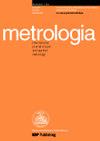用于评估实验室间对物质、材料或物体的名义和序数特征共识的测试能力
IF 2.4
3区 工程技术
Q2 INSTRUMENTS & INSTRUMENTATION
引用次数: 0
摘要
参与实验室间比对的不同实验室根据物质、材料或物体的名义和序数(即分类)特征对其进行分类,通过对实验室反应的总变化进行分解,得出实验室间共识的概念。总变异的一个组成部分是由实验室之间的差异造成的,第二个组成部分是由与应用实验设计相关的条件(如测试项目的温度、技术人员的经验等)造成的。这种分解是基于最近开发的用于名义变量的双向 CATANOVA 和用于顺序变量的双向 ORDANOVA。共识是作为同质性假设进行检验的,即总变异中相应成分的不显著性。共识的力量被认为是同质性检验的力量。本文详细介绍了一种方法,用于评估实验室间比较中获得的分类特征的共识力和相应的错误判定风险与数据集大小的关系。此外,还讨论了利用以前公布的焊接缺陷鉴定实验室间比对数据集和饮用水气味强度检测数据集来评估功率和风险的示例。在 R 编程环境中提供了一个计算机代码示例,用于在名义变量的情况下使用卡方分布计算幂值。此外,还提供了一个新开发的序数变量工具,即一个带有宏的 Excel 电子表格,该工具基于从多叉分布中进行蒙特卡罗抽样。本文章由计算机程序翻译,如有差异,请以英文原文为准。
Power of a test for assessing interlaboratory consensus of nominal and ordinal characteristics of a substance, material, or object
A concept of the consensus among different laboratories participating in an interlaboratory comparison, classifying a substance, material, or object according to its nominal and ordinal (i.e. categorical) characteristics, is devised using decomposition of the total variation of the laboratory responses. One of the components of the total variation is caused by the between-laboratory differences, and the second—by conditions associated with the applied experimental design (for example, temperature of test items, technician experience, etc). This decomposition is based on the recently developed two-way CATANOVA for nominal variables and two-way ORDANOVA for ordinal variables. The consensus is tested as hypotheses about homogeneity, i.e. insignificance of the corresponding components of the total variation. The consensus power is taken to be the power of the homogeneity test. A methodology for evaluation of the consensus power and corresponding risks of false decisions versus the dataset size of categorical characteristics obtained in an interlaboratory comparison is detailed. Examples of evaluation of the power and risks are discussed using previously-published datasets of an interlaboratory comparison of identification of weld imperfections, and an examination of the intensity of the odor of drinking water. An example of computer code in the R programming environment is presented for the power calculations in the case of nominal variables, using a chi-square distribution. A newly developed tool for ordinal variables, an Excel spreadsheet with macros, which is based on Monte Carlo draws from a multinomial distribution, is also available.
求助全文
通过发布文献求助,成功后即可免费获取论文全文。
去求助
来源期刊

Metrologia
工程技术-物理:应用
CiteScore
2.80
自引率
25.00%
发文量
137
审稿时长
12 months
期刊介绍:
Published 6 times per year, Metrologia covers the fundamentals of measurements, particularly those dealing with the seven base units of the International System of Units (metre, kilogram, second, ampere, kelvin, candela, mole) or proposals to replace them.
The journal also publishes papers that contribute to the solution of difficult measurement problems and improve the accuracy of derived units and constants that are of fundamental importance to physics.
In addition to regular papers, the journal publishes review articles, issues devoted to single topics of timely interest and occasional conference proceedings. Letters to the Editor and Short Communications (generally three pages or less) are also considered.
 求助内容:
求助内容: 应助结果提醒方式:
应助结果提醒方式:


